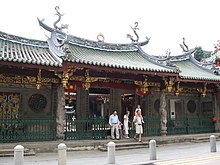
Chinatowns in Asia are widespread with a large concentration of overseas Chinese in East Asia and Southeast Asia and ethnic Chinese whose ancestors came from southern China—particularly the provinces of Guangdong, Fujian, and Hainan—and settled in countries such as Brunei, Cambodia, East Timor, Indonesia, India, Laos, Malaysia, Myanmar, the Philippines, Singapore, Sri Lanka, Thailand, Vietnam, Japan and Korea centuries ago—starting as early as the Tang dynasty, but mostly notably in the 17th through the 19th centuries, and well into the 20th century. Today the Chinese diaspora in Asia is primarily concentrated in Southeast Asia; however, the legacy of the once widespread overseas Chinese communities in Asia is evident in the many Chinatowns found across East, South and Southeast Asia.

Chinatown is a subzone and ethnic enclave located within the Outram district in the Central Area of Singapore. Featuring distinctly Chinese cultural elements, Chinatown has had a historically concentrated ethnic Chinese population.

Tan Tock Seng was a Malacca-born merchant and philanthropist from Singapore.

Chinese Singaporeans are Singaporeans of Han Chinese descent. Chinese Singaporeans constitute 75.9% of the Singaporean citizen population according to the official census, making them the largest ethnic group in Singapore.

The Sri Mariamman Temple is Singapore's oldest Hindu temple. It is an agamic temple, built in the Dravidian style. Located at 244 South Bridge Road, in the downtown Chinatown district, the temple serves the majority Hindu Singaporeans, Tamilians, in the city-state. Due to its architectural and historical significance, the temple has been gazetted a National Monument and is a major tourist attraction. Sri Mariamman Temple is managed by the Hindu Endowments Board, a statutory board under the Ministry of Community Development, Youth and Sports.

Tanjong Pagar is a historic district located within the Central Business District of Singapore, straddling the Outram Planning Area and the Downtown Core under the Urban Redevelopment Authority's urban planning zones. The district has a rich history and is known for its cultural and architectural landmarks, making it a popular tourist destination.

Thian Hock Keng, is a temple built for the worship of Mazu, a Chinese sea goddess, located in Singapore. It is the oldest and most important temple of the Hokkien (Hoklo) people in the country. Another shrine at the back is Buddhist dedicated to Guanyin, the Mahayana Buddhist bodhisattva of mercy.
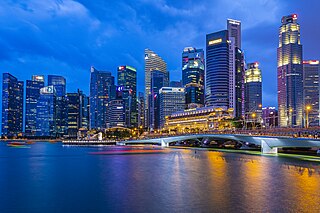
The Central Area, also called the City Area, and informally The City, is the main commercial city centre of Singapore. Located in the south-eastern part of the Central Region, the Central Area consists of eleven constituent planning areas: the Downtown Core, Marina East, Marina South, the Museum Planning Area, Newton, Orchard, Outram, River Valley, Rochor, the Singapore River and Straits View, as defined by the Urban Redevelopment Authority. The term Central Business District (CBD) has also been used to describe most of the Central Area as well, although its boundaries lie within the Downtown Core.

The Jackson Plan or Raffles Town Plan, an urban plan of 1822 titled "Plan of the Town of Singapore", is a proposed scheme for Singapore drawn up to maintain some order in the urban development of the fledgling but thriving colony founded just three years earlier. It was named after Lieutenant Philip Jackson, the colony's engineer and land surveyor tasked to oversee its physical development in accordance with the vision of Stamford Raffles for Singapore, hence it is also commonly called Raffles Town Plan. Raffles gave his instructions in November 1822, the plan was then drawn up in late 1822 or early 1823 and published in 1828. It is the earliest extant plan for the town of Singapore, but not an actual street map of Singapore as it existed in 1822 or 1827 since the plan is an idealised scheme of how Singapore may be organised that was not fully realised. Nevertheless, it served as a guide for the development of Singapore in its early days, and the effect of the general layout of the plan is still observable to this day.

Telok Ayer MRT station is an underground Mass Rapid Transit (MRT) station on the Downtown line (DTL). Situated in Outram, Singapore, the station serves various offices and commercial developments around the junction of Cross Street and Telok Ayer Street. The station is operated by SBS Transit.
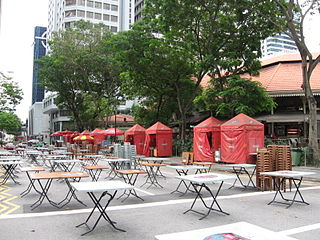
Boon Tat Street is in the Downtown Core in the Central Area of Singapore. The street extends from Amoy Street at its western end to the junction of Shenton Way and Raffles Quay.

Lau Pa Sat, also known as Telok Ayer Market, is a historic building located within the Downtown Core in the Central Area of Singapore. It was first built in 1824 as a fish market on the waterfront serving the people of early colonial Singapore and rebuilt in 1838. It was then relocated and rebuilt at the present location in 1894. It is currently a food court with stalls selling a variety of local cuisine.
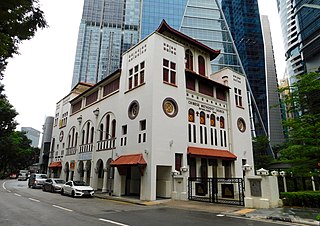
Telok Ayer Chinese Methodist Church, is located on Telok Ayer Street within the Downtown Core of Singapore's central business district. The church is approximately 450 metres from Telok Ayer MRT station.
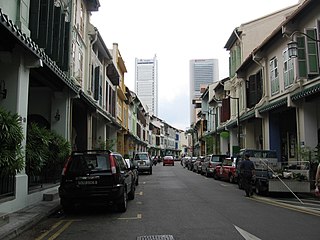
Amoy Street is a one-way street located within Chinatown, within the Outram district in Singapore. The street is close to Tanjong Pagar MRT station.

Stanley Street (Chinese: 史坦利街)is a one-way street in the Telok Ayer area of Chinatown, Singapore. It lies on the boundary between the Downtown Core and Outram Planning Area. The street links McCallum Street to Boon Tat Street. On the left side of the street, it is mainly conserved shophouses and on the right, car park entrances to Cecil Street buildings. The Singapore Hokkien Huay Kuan is located on this street.

Ying Fo Fui Kun is a Hakka clan association in Singapore. Its clan house is located at Telok Ayer Street in the Outram Planning Area, within the Central Area.

Duxton Hill is a small hill, as well as the name of a road, located in Tanjong Pagar in the Downtown Core district of Singapore.

Singapore Hokkien Huay Kuan (SHHK), or the Singapore Hokkien Association in English, is a cultural and educational foundation. It was established in 1840 to promote education, social welfare and the preservation of the Chinese language and culture among Chinese Singaporean and other Overseas Chinese groups in Southeast Asia. As of 2014, the SHHK, which has 5000 members, is the largest clan association in Singapore.



